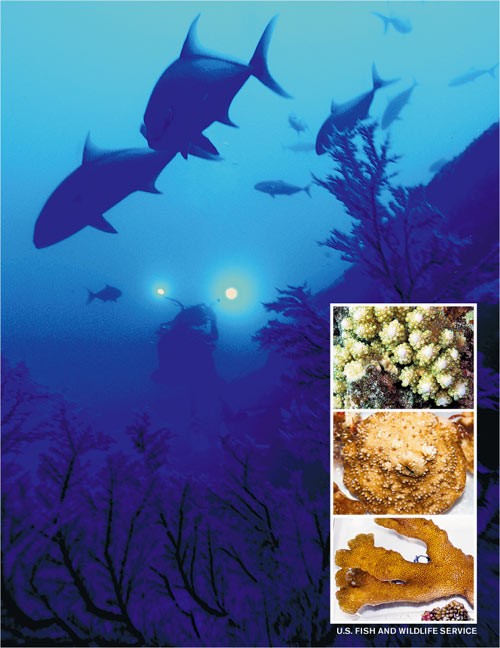Sea temperature rise prompts coral watch

Above, National Oceanic and Atmospheric Administration scientist Greg McFall conducts a video survey at 200 feet at Pearl and Hermes Atoll in the Northwestern Hawaiian Islands as a school of kahala passes by a feathery black coral tree. At right, three new coral species found by scientists on a recent expedition.
Federal marine scientists are watching for a potential high level of coral die-off because of a rise in temperature in the Northwestern Hawaiian Islands — an area that has the highest rate of species found nowhere else in the world.
The "bleaching watch" comes at a time when scientists are discovering new species that could provide clues to the condition of sea life before human contact in the main Hawaiian Islands.
Coral bleaching occurs when, confronted with excessively warm water, the coral expels algae that is the source of its nutrients and ultimately turns white and dies.
Randall Kosaki, the chief scientist on a recent 30-day expedition, said the crew experienced sea surface temperatures as high as 84 degrees.
"That’s unusually warm for these northern reefs, and the warmest month of the year, September, is right around the corner," Kosaki said.
Jim Maragos, a scientist with the U.S. Fish and Wildlife Service, said the research crew found coral species never recorded in the Hawaiian archipelago.
Don't miss out on what's happening!
Stay in touch with breaking news, as it happens, conveniently in your email inbox. It's FREE!
"Several of these will no doubt turn out to be species that are completely new to science," said Maragos, a coral expert.
Scientist have tentatively identified 10 new coral species but have to confirm their findings through further tests and research.
Kosaki said while about 25 percent of the main Hawaiian Islands has marine fish that exist nowhere else in the world, the Northwest Islands’ deep reef has a higher endemic rate: more than 90 percent.
"That really establishes us as one of the focal points for conservation and biodiversity globally. … It’s really going to put us on the map," Kosaki said.
"It’s really an outstanding result. … This is the highest rate of endemism recorded in any marine ecosystem on earth. These reefs are a global treasure trove of biodiversity."
Kosaki said this discovery underscores the importance of the protected status of the Northwestern Hawaiian Islands. The islands are part of the Papahanaumokuakea Marine National Monument, encompassing almost 140,000 square miles.
Kosaki said studies of reefs usually occur between 20 and 70 feet but that expeditions this year and last year included dives to depths of 250 feet discovering deep coral reef fish.
The trips went as far as Kure Atoll, the northernmost coral reef.
Kosaki said scientists have recorded a higher percentage of Hawaiian species found nowhere else in the world in deep reefs as they traveled north, where isolation enabled the species to evolve.
Kosaki said part of the evolution involves tolerating cooler temperatures.
He said in some individual fish counts in deep reefs, scientists found 98 percent to 99 percent Hawaiian endemic species.
"That’s almost unheard of in a marine ecosystem," he said.
As a way to preserve the diversity, scientists have taken samples of coral with plans to grow them at the Waikiki Aquarium.
Scientists said in the event of a coral die-off, the samples grown at the aquarium could be used to preserve and perhaps restore a species.
The aquarium plans to open a marine exhibit of the Northwest Hawaiian Islands early next year.




